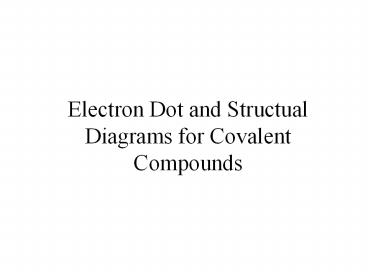Electron Dot and Structual Diagrams for Covalent Compounds - PowerPoint PPT Presentation
1 / 33
Title:
Electron Dot and Structual Diagrams for Covalent Compounds
Description:
Electron Dot and Structual Diagrams for Covalent Compounds Lewis Structures Structural Diagrams show the number of bonds in a compound. Electron Dot Diagrams ... – PowerPoint PPT presentation
Number of Views:99
Avg rating:3.0/5.0
Title: Electron Dot and Structual Diagrams for Covalent Compounds
1
Electron Dot and Structual Diagrams for Covalent
Compounds
2
Lewis Structures
- Structural Diagrams show the number of bonds in a
compound. - Electron Dot Diagrams show the electrons involved
in the bonds of compounds.
Non-bonding e- or lone pairs
Bonding e- 1 pair of electrons 1 bond
3
Electron Dot Diagrams
- Determine the number of valence e- for an
element.
4
7e-
8e-
1e-
valence electrons
2e-
3e-
4e-
5e-
6e-
5
Electron Dot Diagrams
- Determine the number of valence e- for an
element. - H Cl F S O P N C
Si - valence e- 1 7 7 6
6 5 5 4 4
of bonds 1 1 1 2
2 3 3 4 4
When drawing structural diagrams, each element
must have the correct number of bonds.
6
Electron Dot Diagrams
- Each bond in the structural formula represents
two electrons. - All valence electrons must be used
- Each element must have a full valence orbital
(8e-) , except H (2e-) - Try C2H6
7
- First, determine the central atom (the one with
the most bonding electrons) - Carbon 4 e-
- Hydrogen 1 e-
- So the central atoms will be? C
8
Electron Dot Diagrams
- C2H6
.
C
.
.
.
9
Electron Dot Diagrams
- C2H6
.
.
.
.
C
C
.
.
.
.
10
Electron Dot Diagrams
- C2H6
.
.
.
.
.
.
.
.
C
C
.
.
.
.
.
.
All atoms have a full shell
11
Electron Dot Diagrams
- C2H6
.
.
.
.
.
.
.
.
C
C
.
.
.
.
.
.
All atoms have a full shell
12
Electron Dot Diagrams
- A structural diagram is one that shows each bond
as a line. Each line represents 2 bonding
electrons. - Lone pairs are not shown in a structural diagram
- C2H6
13
Electron Dot Diagrams
- HCN
14
Electron Dot Diagrams
- HCN
15
Electron Dot Diagrams
- HCN
H
C
N
16
Electron Dot Diagrams
- HCN
.
.
.
.
C
.
17
Electron Dot Diagrams
- HCN
.
.
.
.
C
.
.
.
.
18
Electron Dot Diagrams
- HCN
.
.
.
.
.
C
.
.
.
.
.
Atoms have full shells All valence electrons
were used
19
Electron Dot Diagrams
- Try drawing the electron dot diagram for
- CO2
20
Electron Dot Diagrams
- Try drawing the electron dot diagram for
- CO2
O C O
21
Electron Dot Diagrams
- Try drawing the electron dot diagram for
- CO2
.
.
.
.
.
.
.
.
.
.
C
.
.
.
.
.
.
Atoms have full shells All valence electrons
were used
22
Electron Dot Diagrams
- Try drawing the electron dot diagram for
- CO2
.
.
.
.
.
.
.
.
.
.
C
.
.
.
.
.
.
Atoms have full shells All valence electrons
were used
23
Electron Dot Diagrams
- Try drawing the electron dot diagram for
- N2
24
Electron Dot Diagrams
- Try drawing the electron dot diagram for
- N2
N N
25
Electron Dot Diagrams
- Try drawing the electron dot diagram for
- N2
.
.
.
.
.
N
.
.
.
.
.
Atoms have full shells All valence electrons
were used
26
Electron Dot Diagrams
- Try drawing the electron dot diagram for
- N2
.
.
.
.
.
N
.
.
.
.
.
Atoms have full shells All valence electrons
were used
27
Electron Dot Diagrams
- Try drawing the electron dot diagram for
- P2O3 (sym)
28
Electron Dot Diagrams
- Try drawing the electron dot diagram for
- P2O3
O P O P O
Hint This molecule is symmetricalwhich means
an O will be in the center.
29
Electron Dot Diagrams
- Try drawing the electron dot diagram for
- P2O3
.
.
.
.
.
.
.
.
.
.
.
.
.
.
.
.
.
.
.
.
O
.
O
O
.
.
.
.
.
.
.
30
Electron Dot Diagrams
- Try drawing the electron dot diagram for
- P2O3
.
.
.
.
.
.
.
.
.
.
.
.
.
.
.
.
.
.
.
.
O
.
O
O
.
.
.
.
.
.
.
31
Electron Dot Diagrams
- Try drawing the electron dot diagram for
- C4H8 (cyclic)
32
Electron Dot Diagrams
- Try drawing the electron dot diagram for
- C4H8 (cyclic)
H
H
.
.
.
.
.
.
.
.
C
C
H
.
.
H
.
.
.
.
.
.
.
H
C
.
.
C
.
H
.
.
.
.
H
H
33
Electron Dot Diagrams
- Try drawing structural diagrams for the
- following C4H8 (cyclic)
H
H
C
C
H
H
H
C
C
H
H
H































